
Around the same time I saw the fox on the Cascade Lakes Highway, I was working on an undergraduate research project at OSU-Cascades. We were in the early stages of fleshing out a study idea using remote cameras to document the behavior of scavenger species around carrion. The work was tedious and unpleasant. Road-killed deer would be moved, with proper permits of course, into the forest. We then mounted remote cameras to see what carnivorous animals would come to feast. The images we captured would be used to test various hypotheses about how wild animals discover carrion and utilize it as a food resource. The job was much worse in the heat of summer, and the smell often
Not long after my family’s roadside fox encounter, my family was back at the lake. On the drive home we again encountered a mule deer that had been struck and killed by a car as it tried to cross the road same less than a mile from where we had seen the fox. It was a valuable opportunity to get a carcass already in the woods. No need to move it very far or touch it more than absolutely necessary. It would be a dirty job nonetheless, but a short downhill drag would have the deer into the trees and in an acceptable location. My family was not thrilled about helping, so I made a quick call to a fellow student who came up that evening and set up a camera.
Several weeks later, we returned to see what we’d caught on camera.
It’s always exciting to retrieve a trail camera. You never know what you’ll see in the images. This time though, we did not expect much. Experience told us that activity around carcasses that time of year is relatively predictable. High summer temperatures mean rapidly decaying meat, a good resource for specialized obligate scavengers, but not necessarily for most other species. Turkey vultures dominated our summertime data. Nevertheless, it had crossed my mind that the fox might visit. A smelly carcass will sometimes attract carnivores out of curiosity if not hunger. Sure enough, as we toggled through the images one-by-one, there was a fox. However this one was not black; she was red just like most people would expect a fox to be. Now we knew there were at least two in the area, and even at that time the significance of the discovery was not lost on us. Only a month earlier news stories had been circulating of a rare fox being recorded on Mt. Hood.
There is a lot we don’t know about native red fox in Oregon. For a long time there was confusion about which subspecies was even present. Earlier sources identified them not as Sierra Nevada, but as Cascade Red Fox, the same subspecies you find in the mountains of Washington State.
Old wildlife distribution maps are full of straight lines which often indicate a gap in scientific understanding at the time more so than a realistic boundary between populations. Some of those maps show the Oregon/California border as the separation between the two subspecies in question. More recently, the science has suggested that the foxes in Oregon are likely more closely related to populations in California, and are the Sierra Nevada subspecies. More data will help answer the question, but in my mind at least, the Columbia River is a far more realistic barrier between them than a human political border, as much as Oregonians may want to believe that Oregon foxes are good at keeping Californian foxes out of the state.
 A few years back, this revelation had some significant policy and management implications. While all three of the Pacific Northwest red fox subspecies are considered to be rare and at risk, in 2010 the Sierra Nevada subspecies was petitioned by environmental groups for Endangered Species Act protection, triggering an official policy process that ideally would be based on lots of good data. But in those early years very little was known about the fox. Many believed the Sierra Nevada subspecies was one of the most imperiled carnivores on the continent, with only a few dozen individuals remaining in a few remnant populations in Northern California. That was before they started popping up in Oregon. Since those early Oregon discoveries in 2011 and 2012, the number of fox sightings has gone up, a lot. Researchers using trail cameras to look for wolverines in 2013 and 2014 turned up no traces of that montane mustelid in the Three Sisters Wilderness, but they did find foxes. My own little scavenger project ultimately documented the animals at four separate locations outside of the wilderness on Mt. Bachelor, and biologists and volunteers working for the nonprofit Friends of the Central Cascades Wilderness have also found them in the area. Foxes have been documented in Crater Lake National Park and on Mt. Hood. Research has been ongoing in the southern portion of their range in California, as well.
A few years back, this revelation had some significant policy and management implications. While all three of the Pacific Northwest red fox subspecies are considered to be rare and at risk, in 2010 the Sierra Nevada subspecies was petitioned by environmental groups for Endangered Species Act protection, triggering an official policy process that ideally would be based on lots of good data. But in those early years very little was known about the fox. Many believed the Sierra Nevada subspecies was one of the most imperiled carnivores on the continent, with only a few dozen individuals remaining in a few remnant populations in Northern California. That was before they started popping up in Oregon. Since those early Oregon discoveries in 2011 and 2012, the number of fox sightings has gone up, a lot. Researchers using trail cameras to look for wolverines in 2013 and 2014 turned up no traces of that montane mustelid in the Three Sisters Wilderness, but they did find foxes. My own little scavenger project ultimately documented the animals at four separate locations outside of the wilderness on Mt. Bachelor, and biologists and volunteers working for the nonprofit Friends of the Central Cascades Wilderness have also found them in the area. Foxes have been documented in Crater Lake National Park and on Mt. Hood. Research has been ongoing in the southern portion of their range in California, as well.
Perhaps more striking than the far flung remote camera detections of shy, elusive foxes off the beaten path, is the fact that recreationists have also been encountering the animals with increasing frequency in much more developed portions of the forest. In recent years some of the animals here in Central Oregon have become habituated to humans, something that is unfortunately not unusual for red foxes throughout their range. On a nearly weekly basis excited members of the public send me photos of foxes. My inbox has photos of a black fox by the road during Pole-Pedal-Paddle, and a red one under the ski lift at Timberline. Visitors show me cell phone images of foxes at Hoodoo, and foxes standing between the cars at the snow parks on Mt. Bachelor looking for scraps of food.
The Cascade foxes of Mt. Rainier in Washington are also famously tame, allowing tourists to hand feed them and take photographs. Constant sightings of a few habituated animals creates the impression of abundance and a burgeoning population, sometimes making the issue confusing for public audiences at the museum when we attempt to weave a complex story of habitat loss, climate change, conservation concerns, and huge gaps in the data for red foxes, despite their apparent weakness for hotdogs and other free handouts in the Mt. Bachelor parking lot.
Clearly, there was work to be done. Museum staff partnered with the US Fish and Wildlife Service (USFWS) and Oregon Department of Fish and Wildlife (ODFW) to search for the elusive red foxes.


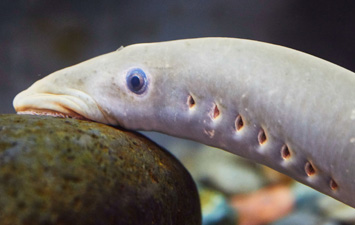
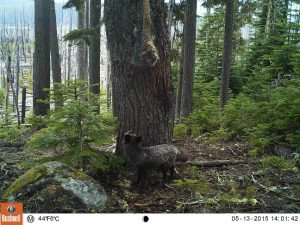
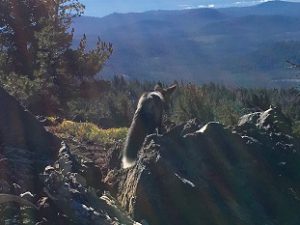
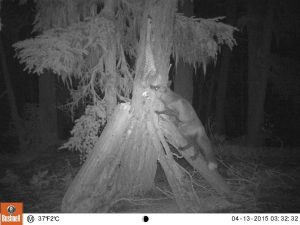 A few years back, this revelation had some significant policy and management implications. While all three of the Pacific Northwest red fox subspecies are considered to be rare and at risk, in 2010 the Sierra Nevada subspecies was petitioned by environmental groups for Endangered Species Act protection, triggering an official policy process that ideally would be based on lots of good data. But in those early years very little was known about the fox. Many believed the Sierra Nevada subspecies was one of the most imperiled carnivores on the continent, with only a few dozen individuals remaining in a few remnant populations in Northern California. That was before they started popping up in Oregon. Since those early Oregon discoveries in 2011 and 2012, the number of fox sightings has gone up, a lot. Researchers using trail cameras to look for wolverines in 2013 and 2014 turned up no traces of that montane mustelid in the Three Sisters Wilderness, but they did find foxes. My own little scavenger project ultimately documented the animals at four separate locations outside of the wilderness on Mt. Bachelor, and biologists and volunteers working for the nonprofit Friends of the Central Cascades Wilderness have also found them in the area. Foxes have been documented in Crater Lake National Park and on Mt. Hood. Research has been ongoing in the southern portion of their range in California, as well.
A few years back, this revelation had some significant policy and management implications. While all three of the Pacific Northwest red fox subspecies are considered to be rare and at risk, in 2010 the Sierra Nevada subspecies was petitioned by environmental groups for Endangered Species Act protection, triggering an official policy process that ideally would be based on lots of good data. But in those early years very little was known about the fox. Many believed the Sierra Nevada subspecies was one of the most imperiled carnivores on the continent, with only a few dozen individuals remaining in a few remnant populations in Northern California. That was before they started popping up in Oregon. Since those early Oregon discoveries in 2011 and 2012, the number of fox sightings has gone up, a lot. Researchers using trail cameras to look for wolverines in 2013 and 2014 turned up no traces of that montane mustelid in the Three Sisters Wilderness, but they did find foxes. My own little scavenger project ultimately documented the animals at four separate locations outside of the wilderness on Mt. Bachelor, and biologists and volunteers working for the nonprofit Friends of the Central Cascades Wilderness have also found them in the area. Foxes have been documented in Crater Lake National Park and on Mt. Hood. Research has been ongoing in the southern portion of their range in California, as well.
 North America has native foxes as well, 13 subspecies according to some sources. Three of those species live in the Pacific Northwest. All three are frequently referred to as “montane fox”, or foxes that live in the mountains. The Rocky Mountain Red Fox (Vulpes vulpes macroura) is found in the Rockies and the Blue Mountains of Eastern Oregon, while the Cascades Fox (Vulpes vulpes cascadensis) and the Sierra Nevada Red Fox (Vulpes vulpes necator) inhabit the mountains running up the middle of Northern California, Oregon, and Washington. These animals evolved to live, so the theory goes, in a much cooler prehistoric North America. As the climate warmed over the millennia, these foxes retreated to the mountains. There among the conifer forests and talus slopes they adapted to deep winter snows, cold temperatures and a harsh environment.
North America has native foxes as well, 13 subspecies according to some sources. Three of those species live in the Pacific Northwest. All three are frequently referred to as “montane fox”, or foxes that live in the mountains. The Rocky Mountain Red Fox (Vulpes vulpes macroura) is found in the Rockies and the Blue Mountains of Eastern Oregon, while the Cascades Fox (Vulpes vulpes cascadensis) and the Sierra Nevada Red Fox (Vulpes vulpes necator) inhabit the mountains running up the middle of Northern California, Oregon, and Washington. These animals evolved to live, so the theory goes, in a much cooler prehistoric North America. As the climate warmed over the millennia, these foxes retreated to the mountains. There among the conifer forests and talus slopes they adapted to deep winter snows, cold temperatures and a harsh environment.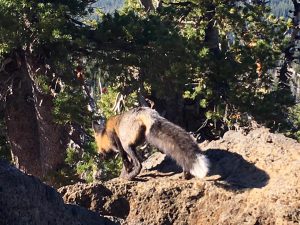 As skiers in Central Oregon are well aware, those snowy high elevation conditions are increasingly unreliable. A changing climate and human development put species dependent on high mountain habitats at risk. In many recent years the snow has barely come at all. Other years it is heavy but wet, melts quickly, and is gone earlier in the spring.
As skiers in Central Oregon are well aware, those snowy high elevation conditions are increasingly unreliable. A changing climate and human development put species dependent on high mountain habitats at risk. In many recent years the snow has barely come at all. Other years it is heavy but wet, melts quickly, and is gone earlier in the spring.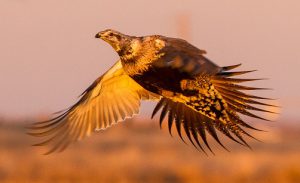
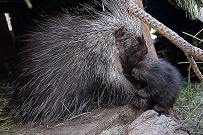
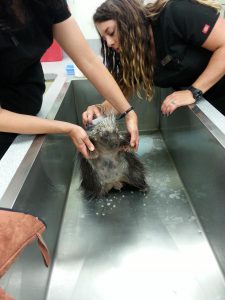
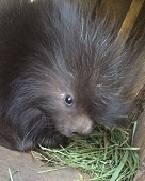 Honey has taken to motherhood and is protective of her baby, often standing in between it and viewers who linger a little too long for her liking. As with wild porcupettes, our newest member usually hides out during the day and seeks shelter in a safe area on the ground while its mother retreats to the trees drawing attention away from her offspring. We’ve tried to minimize our handling of the porcupette and don’t yet know its gender.
Honey has taken to motherhood and is protective of her baby, often standing in between it and viewers who linger a little too long for her liking. As with wild porcupettes, our newest member usually hides out during the day and seeks shelter in a safe area on the ground while its mother retreats to the trees drawing attention away from her offspring. We’ve tried to minimize our handling of the porcupette and don’t yet know its gender.
 I, of course, had no idea what I was doing, so a good gentleman by the name of Jim Malloy took me under his wing and showed me the basics. Jim Malloy himself is the President of the Beaver State Historical Gunmakers Guild located in Prineville, Oregon. I foolishly assumed that the kit would come to us quite nearly completed and all that we would have to do is make it look pretty. I have never been so wrong in my life.
I, of course, had no idea what I was doing, so a good gentleman by the name of Jim Malloy took me under his wing and showed me the basics. Jim Malloy himself is the President of the Beaver State Historical Gunmakers Guild located in Prineville, Oregon. I foolishly assumed that the kit would come to us quite nearly completed and all that we would have to do is make it look pretty. I have never been so wrong in my life.
 When I first began working for the High Desert Museum, I was elated to find something tucked away in the vault that I never expected here: this 42 Liberator. It immediately became my favorite object in the collection. I am a huge fan of vintage Harley-Davidsons for many reasons but have always been drawn to the sense of freedom they embody. It would be difficult to find a better ambassador of freedom than a Liberator. What makes this motorcycle so important to me is what it paved the way for. With the popularity and economic strength Harley-Davidson had after WWII, the company was able to launch a brand new big V-twin engine in 1948, affectionately known as the Panhead. I was born and raised on the back of my father’s Panhead which I now own and ride, over 30 years later.
When I first began working for the High Desert Museum, I was elated to find something tucked away in the vault that I never expected here: this 42 Liberator. It immediately became my favorite object in the collection. I am a huge fan of vintage Harley-Davidsons for many reasons but have always been drawn to the sense of freedom they embody. It would be difficult to find a better ambassador of freedom than a Liberator. What makes this motorcycle so important to me is what it paved the way for. With the popularity and economic strength Harley-Davidson had after WWII, the company was able to launch a brand new big V-twin engine in 1948, affectionately known as the Panhead. I was born and raised on the back of my father’s Panhead which I now own and ride, over 30 years later. We’re excited to have just added a fifth owl species to our collection: the barred owl. This beautiful and remarkable species joins our popular hawks, eagles and falcons currently on exhibit.
We’re excited to have just added a fifth owl species to our collection: the barred owl. This beautiful and remarkable species joins our popular hawks, eagles and falcons currently on exhibit.